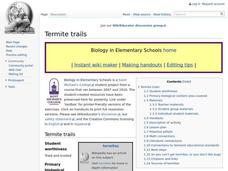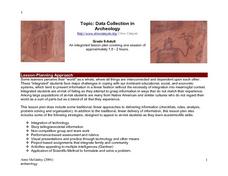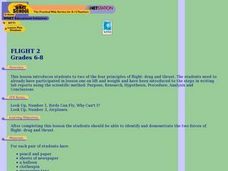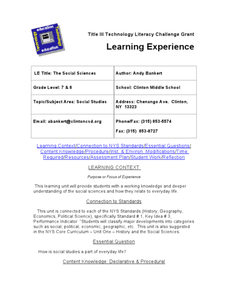Curated OER
Finding Wind Direction
Students identify the wind direction. In this weather lesson, students use a weather vane to find the wind direction. Students complete a worksheet.
Curated OER
Fresh Greens In The Home
Students engage in the study of nutritional food choices that include fresh greens. They investigate the benefits of using simple planting techniques. The lesson also includes recipes for students to try out the habit of eating more food...
Curated OER
Metals, Nonmetals, Metalloids
Students recognize that metals, nonmetals, and metalloids have common attributes. They Identify physical and chemical properties. Students define ores and identify where ores can be found.
Curated OER
Focus on Friction
The students learn about friction and forces through direct instruction and an investigation. They use measurement skills, observation skills, predicting, and drawing conclusions based on data collected during the investigation. Students...
Curated OER
Termite Trails
Students observe termite trail-following behavior. For this termite trails lesson, students draw a circle or other shape approximately eight inches across with a ball point pen. Teacher taps out termites into the circle and...
Curated OER
To Light or Not to Light
Students examine the role of light and dark in a living environment. In this photosynthesis lesson, students hypothesize about the best environment for plant growth, record observations using plant seeds in various light and dark...
Curated OER
Build An Island
Students explore erosion. In this science lesson plan, students build an island and observe the effects of erosion on the island. Students discuss freshwater ecosystems in Hawaii.
Curated OER
Inventing and Presenting Unit 2: Effective Speeches and Building the Invention
Students identify the characteristics of effective speeches. Students find elements of good speeches in the text and in the delivery of model speeches. Students build a working three-dimensional model of an invention or an actual...
Curated OER
Deadly Disease among Us
High schoolers recognize that infectious diseases are a continuing problem among all human populations. They define and give examples of emerging infectious diseases. Students define and give examples of re-emerging infectious diseases.
Curated OER
Leaves, Flowers, Seashells, Mirrors and Symmetry
Young scholars develop an understanding of patterns and symmetry. In this symmetry and pattern lesson, students use real world patterns then analyze and extend them. Young scholars also use real world items while discovering and...
Curated OER
Data Collection in Archaeology
Learners research different types of rock art and categorize it into basic groups, classify Powerpoint Images according to interpretation, enter findings into Access template, and interpret results after comparing information with rest...
Curated OER
BEAMS Spelling Search
In this science and spelling instructional activity, students circle the misspelled word in each of 12 sentences. They write the correct spelling on the blank line at the end of each sentence.
Curated OER
The Effects of Water Quality on the Growth Rate of Freshwater Mussels
Students participate in a field and laboratory study to determine if local freshwater mussels are environmentally stressed.
Curated OER
What Really Matters When it Comes to Sound?
Students conduct experiments to learn about sound wave vibrations in objects and pitch. Students test how varying the volume of water in a vessel changes frequency and pitch.
Curated OER
Flight 2
Students are introduced to two of the four principles of flight: drag and thrust. As the class watches a video on these principles, they utilize ballons, straws and clothepins to simulate what they're seeing in the show. Nice, hands-on...
Curated OER
The Social Sciences
Students search for examples of social science in and around their school. They create a Social Science scrapbook of the eight social sciences, that includes news articles and summaries that focus on each social science area.
Curated OER
Breads And Nutritional Labels
Seventh graders investigate the concept of a nutritional label used on bread products. They read different labels in order to strengthen reading skills and interpreting nutritional information. The information is used in order to create...
Curated OER
Why Oil and Water Don't Mix
Second graders explore why oil and water do not mix. They make and record their predictions and observe the experiment in which cooking oil is mixed with a glass of water. Students discuss why they think the oil and water did not mix and...
Curated OER
Pumpkin Properties are a Smash!
Students receive a miniature pumpkin and proceed through several stations to measure a variety of physical properties. The data is entered into a data sheet and the mass and volume measurements are used to calculate density. They also...
Curated OER
Interpreting the History, Geology, and Ecology of Monterey Bay
Students explore what they know about Monterey Bay in the special topics course and share their information with K-12 grade children at local schools by participating in the Virtual Canyon Project. Students in this service learning...
Curated OER
Celebrating 100 Years of Flight
Students practice reading comprehension, note taking and writing skills. In this literacy and writing lesson, students read about the invention of airplanes, women pilots and the space race before writing their own news article on "100...
Curated OER
Biology E3 Project Instructional Plan
Ninth graders design a device to treat aneurism. In this biology lesson, 9th graders create a polymer in the lab and explain its uses. They identify the different diseases affecting the circulatory system.
Curated OER
As the Sun Burns
Students examine the types of light the sun gives the Earth. They describe the electro-magnetic spectrum and how to protect themselves from different types of light. They identify the layers of the atmosphere as well.
Curated OER
Titration and Molarity
Students are introduced to the concepts of molarity and titration. As a class, they develop a list of the correct steps they need to follow to create a specific concentration of a solution. They design and complete an experiment in...























